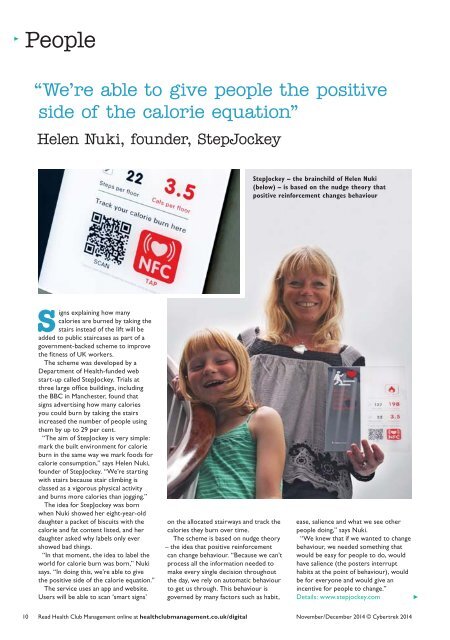DR JOHN MORGAN
You also want an ePaper? Increase the reach of your titles
YUMPU automatically turns print PDFs into web optimized ePapers that Google loves.
People<br />
“We’re able to give people the positive<br />
side of the calorie equation”<br />
Helen Nuki, founder, StepJockey<br />
StepJockey – the brainchild of Helen Nuki<br />
(below) – is based on the nudge theory that<br />
positive reinforcement changes behaviour<br />
igns explaining how many<br />
calories are burned by taking the<br />
S stairs instead of the lift will be<br />
added to public staircases as part of a<br />
government-backed scheme to improve<br />
the fitness of UK workers.<br />
The scheme was developed by a<br />
Department of Health-funded web<br />
start-up called StepJockey. Trials at<br />
three large office buildings, including<br />
the BBC in Manchester, found that<br />
signs advertising how many calories<br />
you could burn by taking the stairs<br />
increased the number of people using<br />
them by up to 29 per cent.<br />
“The aim of StepJockey is very simple:<br />
mark the built environment for calorie<br />
burn in the same way we mark foods for<br />
calorie consumption,” says Helen Nuki,<br />
founder of StepJockey. “We’re starting<br />
with stairs because stair climbing is<br />
classed as a vigorous physical activity<br />
and burns more calories than jogging.”<br />
The idea for StepJockey was born<br />
when Nuki showed her eight-year-old<br />
daughter a packet of biscuits with the<br />
calorie and fat content listed, and her<br />
daughter asked why labels only ever<br />
showed bad things.<br />
“In that moment, the idea to label the<br />
world for calorie burn was born,” Nuki<br />
says. “In doing this, we’re able to give<br />
the positive side of the calorie equation.”<br />
The service uses an app and website.<br />
Users will be able to scan ‘smart signs’<br />
on the allocated stairways and track the<br />
calories they burn over time.<br />
The scheme is based on nudge theory<br />
– the idea that positive reinforcement<br />
can change behaviour. “Because we can’t<br />
process all the information needed to<br />
make every single decision throughout<br />
the day, we rely on automatic behaviour<br />
to get us through. This behaviour is<br />
governed by many factors such as habit,<br />
ease, salience and what we see other<br />
people doing,” says Nuki.<br />
“We knew that if we wanted to change<br />
behaviour, we needed something that<br />
would be easy for people to do, would<br />
have salience (the posters interrupt<br />
habits at the point of behaviour), would<br />
be for everyone and would give an<br />
incentive for people to change.”<br />
Details: www.stepjockey.com<br />
10<br />
Read Health Club Management online at healthclubmanagement.co.uk/digital<br />
November/December 2014 © Cybertrek 2014



